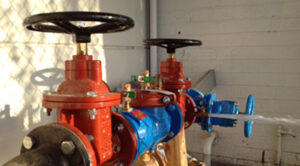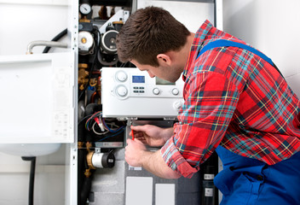Backflow testing is essential to keeping your home’s water safe and sanitary. A licensed plumber will manage everything from shutting off your water to filing the proper report with city regulations.

Backflow preventers ensure that your clean water only flows in one direction. This is important because backflow can contaminate the water with feces, pesticides, chemicals, and other hazardous materials. Visit https://www.plumbing-express.com/ to learn more.
The check valve is a spring-loaded hinged clapper that keeps water from flowing backward through the pipes. This clapper closes to restrict flow when pressure downstream is higher than the pressure upstream, preventing backflow and equipment damage. Check valves can be installed in either horizontal or vertical piping runs. They can be inserted into pipe sizes up to 2 inches. Various styles, materials, and designs are available for specific applications and environmental conditions.
When checking a check valve, the tester should look for any damage, rust, and debris that could inhibit operation. Common failures include worn seat seals, lodged debris, or damaged valve parts due to improper maintenance or installation. The tester should also ensure the check valve is positioned correctly. Incorrect positioning can cause the valve to chatter or vibrate and could result in premature valve wear. The valve should be centered in the line and given enough space from other devices that can create turbulence. Check valves should always be positioned with the flow arrow pointed upstream and in a straight section of piping that can accommodate the maximum flow velocity.
Another backflow preventer type is the Reduced Pressure Zone (RPZ) assembly. This backflow device is designed to protect the public drinking water supply in high-hazard situations. It works by disposing of any backwards-flowing water from building systems into the city’s main supply line. This protects against contaminants like fertilizers, pesticides, and chemicals that can make their way back into the municipal water system.
This backflow preventer can be used in residential, commercial, and industrial plumbing systems. It can be used with potable or nonpotable water, and it can even protect against reverse-flow sewage. This backflow preventer is required by state and local plumbing codes, so it must be regularly tested and maintained to maintain compliance with these regulations.
This type of backflow preventer is not as effective as a double-check valve assembly in low-hazard conditions, but it can still serve its purpose in high-risk situations. It’s important for building owners and engineers to understand the differences between these backflow prevention assemblies so they can get the best protection for their buildings and the public water supply.
Relief Valve
During backflow testing, the technician will use a pressure gauge to check that the gate valve and relief valve maintain a minimum amount of water pressure. If they don’t, the backflow assembly will fail to pass the test. The tester also tests the relief valve to ensure it opens when needed, and that it does so before the differential pressure reaches its opening point.
The purpose of the relief valve is to protect a system from excessive pressure. When a backflow preventer assembly experiences a significant pressure increase, the relief valve is activated. This is done to relieve the excess pressure before damage or personal injury occurs. The pressure increases can be the result of backflow, thermal expansion, or other factors. The relief valve will discharge water through a test port, number four, until the pressure in the Zone of Reduced Pressure drops below the supply side of the assembly.
A relief valve has a diaphragm that is actuated by the pressure in the Zone of Reduced Pressure and a spring that is operated by the pressure in the system. The Zone of Reduced Pressure is a small area between the first and second check valves that is pressurized by the first check’s spring (for example, 90 PSI). The pressure in this zone must be lower than the supply pressure in order for the first check to open. The difference in pressure between the two sides of the diaphragm will allow water to flow through the Relief Valve and into the System of the End User, preventing backflow.
While the relief valve is designed to prevent backflow, it can leak or malfunction over time. In this case, it’s best to call a plumber to investigate the issue and replace the valve. A backflow prevention valve is a vital component of any building’s plumbing system, and its proper maintenance is essential to keeping your water clean and safe.
A well-maintained backflow preventer valve will be able to function for years, but a faulty one could lead to serious problems. To avoid backflow and potential damages, it’s important to have your valves tested regularly.
Pressure Gauge
The pressure gauge is a vital part of the test kit that measures the pressure drop across backflow preventer assemblies. The test gauge will indicate whether the assembly is functioning correctly or if the assembly needs repair. The pressure gauge can also tell the tester if the assembly is leaking or has too much pressure inside.
The types of pressure gauges available differ by the media being monitored and the conditions in which the gauge is used. For example, the gauge must be able to withstand impacts, vibrations, temperature changes, and pulsations of pressure. Gauges are available with a variety of display options, including digital and analog displays.
When a pressure gauge is being tested for accuracy, the tester will compare it to an accurate reference device. If the readings on both ascending and descending scales differ by more than an allowable amount, then the gauge will need to be calibrated. Calibration involves simulating a backflow test and inspecting all of the components of the backflow test kit.
During the calibration process, the tester will verify that all of the connections between the gauge and needle valves, hoses and test cock fittings are drip-tight. The tester will also check that the hoses are holding working pressure, and that the end fittings are not leaking. In addition, the tester will flush the test cocks and bleed valves to ensure that no debris has entered the critical moving parts of the gauge.
Most gauges require an internal stop to prevent the traveling parts from moving beyond their normal range. This is usually accomplished by a diaphragm or bellows with an elastic element. The elements are inside the gauge body, which is made from different materials. Depending on the type of gauge and the materials, these can corrode and deposit debris that restricts the movement of the elastic element, resulting in inaccurate gauge readings. This can be caused by contaminants injected through the test cocks, dirt that is pushed into critical moving areas of the gauge or restrictions from rust in the gauge body. The best way to reduce the chance of contamination is to use a clean and sanitary test kit every time, and to pressurize it slowly to prevent any pressure spikes that might damage the gauge or test cocks.
Test Kit
Backflow testing involves using a special test kit that can measure pressure and gauges. A plumber will connect the test kit to your BPD and monitor the pressure for signs of backflow. This process will also help the tester determine what may be causing it, like a water leak. Because of the need to monitor pressure, your plumber will have to shut off your main water for about 30 minutes. This can be frustrating, but it’s a small price to pay to ensure that your backflow device is working properly.
During backflow testing, your plumber will also need to take readings of the disinfectant residual, pH, Alkalinity, Calcium Hardness, and Combined Chlorine. This information is necessary to make sure that your backflow preventer meets local health regulations. Without regular testing, you could be drinking contaminated water that poses a health risk to you and your family.
Your backflow preventer is important because it ensures that the water in your home only travels in one direction. This is vital because if it were to travel backward, contaminants from the sewer system would be introduced into your clean drinking water. This could cause serious problems for you and your family, including heart disease and cancer. In addition to keeping your family safe, your backflow preventer also keeps buildings from getting ruined by water that moves backward. When H2O travels backward, it is likely to bump into walls and corrode them over time. This can lead to drywall crumbling and eventually ruin the structure of your building. With the right backflow prevention device and tests, you can protect your property and your neighbors’ safety.
Your backflow preventer is required to be tested annually. If it’s due for testing, you will receive a letter from the city a month or so before the test date. A licensed backflow tester can inspect and submit the report to the city on your behalf. The process is relatively simple but requires examining multiple working parts and a thorough knowledge of local backflow laws.
